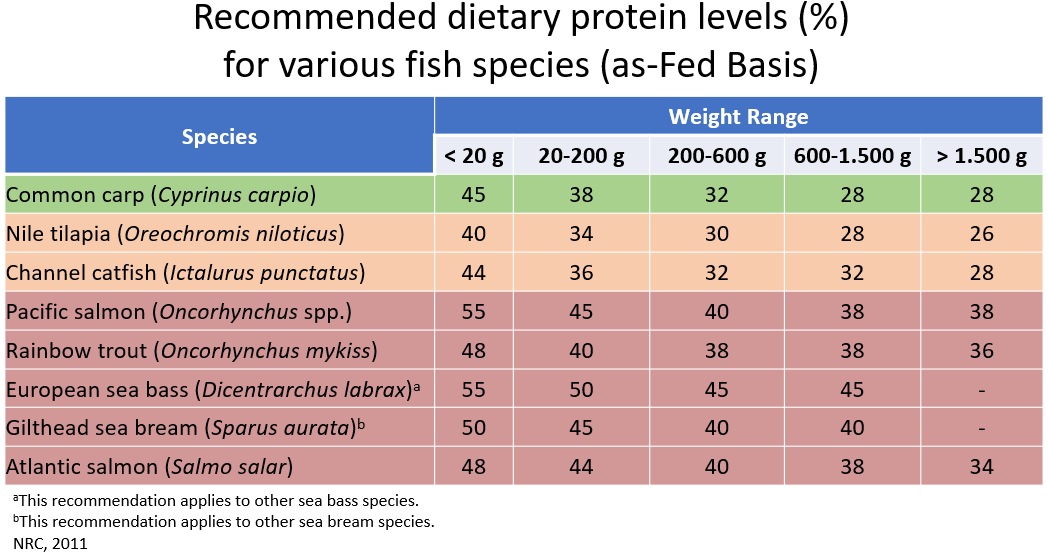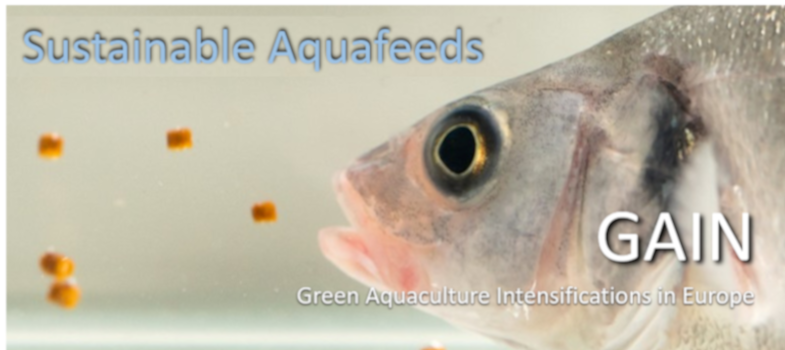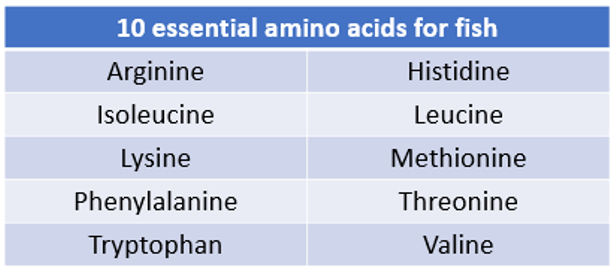Essential Amino Acids
Fish do not have a specific protein requirement, but rather they have a requirement for amino acids, which are protein-building blocks. Meaning that fish need essential amino acids in their diet, not protein itself.
In the process of digesting protein, amino acids are released and absorbed into the body either as individual amino acids or shorter chains of amino acids - peptides.
Fish require ten amino acids (Table 1) in their diets because they are either incapable of synthesizing them or can synthesize them at a rate inadequate to meet their needs. In terms of non-essential amino acids, fish can normally synthesize them at a rate that meets cellular requirements.
Table 1. List of essential amino acids for fish
Assuming that there was a fish feed that contained each essential amino acid in the exact amounts required by any given species of fish, then it would be called the ideal protein. In other words, no amino acids will be deficient or excess when using this ideal protein.
Ideal protein concept (no amino acid deficiency or excess):
- No amino acids used for energy purposes
- Amino acids used efficiently (maximum feed efficiency) = Growth
In addition, feed composition changes would not affect the relative ratios of amino acids, and therefore, the concept of an ideal protein is based on the principle that amino acids need to be provided in a specific ratio in order to function optimally. The synthesis of new structural proteins will be maximized in growing fish fed such a diet, resulting in maximum feed efficiency and growth.
Table 2 provides practical estimates of dietary protein requirements of fish (herbivorous, omnivorous, and carnivorous species) as a percentage of the diet.

Table 2. Recommended dietary protein levels (%) for various fish species (as-Fed Basis)
Protein requirements decrease as fish grow and age. In the early stages, fish need a diet containing high levels of crude protein. While the fish grow, this requirement drops, and in the last growth stage they can satisfy it with lower dietary crude protein compared to the initial phases. The table also shows that carnivorous fish species need higher levels of dietary protein (up to 55% during larval stages) compared to herbivores and omnivores. Remember that the best approach is to provide the correct amount of each amino acid within the total protein content for the target species.
Before going further, read this article regarding the concept of ideal protein in the formulation of aquaculture feeds.
Table 3 presents the required amounts of essential amino acid for Tilapia, European Sea Bass, and Tiger Shrimp, but more can be found in specialized books that compile and publish these data for formulators, like the NRC, 2011 (NRC, 2011. Nutrient requirements of fish and shrimp. National Academies Press, Washington D. C., USA).

Table 3. List of amino acids dietary requirements for some aquatic species.
An important point to consider is that if the minimum amount of an amino acid isn't reached, this will be the limiting factor for the set. The scarcest amino acid will, therefore, limit the growth of an organism (if it is not provided in the proper amount).
As aquafeeds are made from ingredients that vary immensely in terms of nutrients, they also differ in terms of amino acids. Learn one way to overcome the limitations of this amino acid found in ingredients derived from plants and processed animal by-products by reading the following article here.As mentioned before, fish do not have a real requirement for protein, but for rations with adequate amounts and proportions of essential and non-essential amino acids. Like other animals, fish require rations with adequate values of arginine, histidine, isoleucine, leucine, lysine, methionine, phenylalanine, threonine, tryptophan, and valine. Therefore, it is necessary to develop feeds that are nutritionally efficient and have a high feed conversion rate, thereby minimizing the discharge of organic matter and nutrients into the effluents. Determining amino acid requirements allows the formulation of fish diets more accurately because it reduces the need for diets formulated with an excess of some amino acids to meet limiting amino acid requirements. It is important to balance amino acids in plant-based protein diets to reduce nitrogen losses, improve feed conversion ratios and increase fish growth. It is also important to develop mathematical models to simulate and predict fish responses to supplement energy and nutrient levels on performance and production costs under varying conditions.

